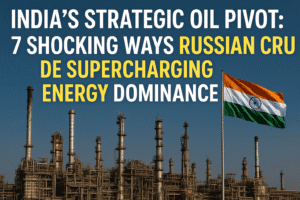India’s Strategic Oil Pivot: 7 Shocking Ways Russian Crude Is Supercharging Energy Dominance
India has decisively become the primary global buyer of Russia’s Urals crude, absorbing 80% of its seaborne exports in 2025. This dominance is largely propelled by aggressive procurement from private refiners Reliance Industries and Nayara Energy, which together secured 45% of Russia’s shipments, with Reliance alone emerging as the world’s single largest purchaser under a pivotal decade-long supply contract. While initially driven by attractive discounts following Western sanctions, India’s deepening reliance now serves a critical strategic purpose: securing stable energy supplies amidst persistent Middle East volatility and threats to vital Hormuz Strait transit routes. China’s reduced purchases further opened the door for India.
However, this surge has tightened the Urals market, slashing spot discounts for India’s state-owned refiners and forcing them to urgently diversify sources like African crudes. Simultaneously, India’s massive purchases provide vital wartime revenue for Russia, cementing a complex energy interdependence. The future balance remains dynamic, influenced by narrowing discounts, OPEC+’s planned market share push, and ongoing diversification efforts.

India’s Strategic Oil Pivot: 7 Shocking Ways Russian Crude Is Supercharging Energy Dominance
India’s energy landscape has undergone a seismic shift. Once a minor buyer, India now dominates Russian seaborne Urals crude exports, absorbing a staggering 80% of shipments in 2025. This isn’t just a transactional change; it’s a fundamental reshaping of global energy flows with profound strategic and economic implications.
The Scale of the Shift:
- Dominant Buyer: By late June 2025, India had purchased 231 million barrels of Urals crude.
- Private Sector Powerhouse: Reliance Industries (Mukesh Ambani) and Nayara Energy aren’t just participants; they are driving the surge, collectively snapping up 45% of Russia’s total Urals exports.
- Reliance Leads the World: Reliance alone secured 77 million barrels this year, making it the single largest global buyer of Urals crude.
- Deepening Dependence: For Reliance, Urals now constitutes 36% of its total crude intake, a massive leap from just 10% in 2022. Nayara’s reliance is even more acute, with Urals making up 72% of its procurement, up from 27% three years ago.
Why the Rush to Russian Oil?
- The Discount Driver (Evolving): Post-Ukraine invasion sanctions, heavily discounted Russian oil offered India significant economic relief. This initial price advantage was a primary magnet.
- Strategic Securing: Reliance’s landmark decade-long contract (starting Jan 2025) for up to 500,000 barrels per day signals a move beyond opportunistic buying to long-term energy security planning. It locks in predictable supply.
- Geopolitical Hedge: Amidst ongoing volatility in the Middle East, including the Israel-Iran conflict and repeated threats to Hormuz Strait transit (a critical chokepoint for Middle Eastern oil), Russian seaborne crude offers a diversified supply route less susceptible to those specific disruptions.
- China’s Retreat: Stringent Chinese tax policies and weaker domestic demand have caused traditional Chinese buyers of Russian oil to pull back, creating a vacuum India was ready and willing to fill.
The Ripple Effects:
- Squeezing State Refiners: The aggressive buying by Reliance and Nayara has tightened the Urals market for India’s state-owned refiners (IOC, BPCL, HPCL). Spot market discounts have dwindled dramatically, falling to under $2 per barrel vs. Dated Brent from $4 a year ago. Limited long-term contracts and currency restrictions further hinder state refiners.
- Russia’s Revenue Lifeline: India’s purchases, controlling 74% of Urals exports in 2024, provide a crucial financial lifeline for Russia, offsetting lost European markets. India’s refineries are now vital nodes in Russia’s wartime economy.
- The Diversification Dance: Recognizing the risks of over-reliance, state refiners are exploring alternatives. HPCL, for instance, is broadening its portfolio with crudes from African nations like Gabon and Congo.
- The Middle Eastern Wildcard: OPEC+’s stated goal to regain market share could increase availability of Middle Eastern crudes later in 2025. Analysts like Kpler’s Yan Rong Fong suggest this could lead to higher Saudi Arabian flows to India, potentially offering state refiners more options and reshaping the competitive landscape.
Beyond the Barrel: A Calculated Strategy
This isn’t merely about buying cheap oil. India is executing a sophisticated energy strategy:
- Leveraging Market Power: Private refiners used their scale and agility to secure advantageous long-term deals unavailable to state players.
- Balancing Risk: While deepening ties with Russia, state refiners (and potentially private ones later) are actively seeking other sources to avoid over-exposure to any single supplier or region, especially given geopolitical uncertainties.
- Economic Imperative: Securing affordable energy remains paramount for India’s growth, even as it navigates complex global sanctions regimes indirectly.
The Road Ahead:
India’s position as Russia’s premier oil customer is entrenched for now, driven by deep contracts and strategic necessity. However, the narrowing discounts, evolving OPEC+ strategies, and the constant shadow of geopolitical risk mean this partnership is dynamic. India’s state refiners are already signaling a push for diversification, while the world watches how the delicate balance between securing affordable energy and managing geopolitical relationships will unfold. India hasn’t panicked; it has positioned itself pragmatically in a turbulent market, ensuring its energy engines keep running. The challenge now is maintaining that balance as the global oil chessboard continues to shift.
You must be logged in to post a comment.